FullSession vs. Hotjar Heatmaps: Which Wins for SaaS? ...

How to Speed Up Product Adoption With User Behavior Tools
Product adoption is critical for measuring the success of your product and business overall. Improving product adoption has become a challenge for most companies, so there is an increasing focus on user behavior tools that support adoption efforts.
User behavior tools can impact product adoption by giving your team insights into how users interact with your product. For example, a platform like our FullSession helps you improve various aspects of your site with session recording tools and website heatmap tools.
You can also get customer feedback via website feedback forms, understand where users experience issues, and optimize your product accordingly.
Schedule a demo to see how our behavior analytics tool works, or test all features by starting your 14-day free trial!
This blog post will explain the importance of product adoption, walk you through the benefits, discuss common barriers and explain how to overcome them with FullSession.
Let's start by explaining what product adoption is.
What is product adoption?
Product adoption includes using a new product or service to achieve specific goals. The product adoption process generally consists of learning and experimentation, during which users try out the new product or service to see if it meets their needs.
If the product or service is helpful, users may use it more regularly, eventually incorporating it into their everyday routines.
By understanding the factors influencing product adoption, businesses can increase the chances of success for their new product or service and ultimately boost their revenue.
Why is product adoption important?
There are a few key reasons why product adoption is so important. First, when customers adopt your product, they use it because it brings more value than other solutions on the market.
Second, product adoption is a crucial metric for determining whether a product is successful. If customers adopt your product, it's a good sign that it meets their needs. Conversely, if customers don't embrace your product, it's a sign of a problem you need to address.
Finally, product adoption is vital for generating revenue. If customers are using your product, they're more likely to pay for it. Even if they're not paying for it, they're more likely to recommend it to others, leading to more customers and revenue.
In short, product adoption is essential because it's a key indicator of success, generates revenue, and provides valuable customer feedback.
What is the product adoption curve?
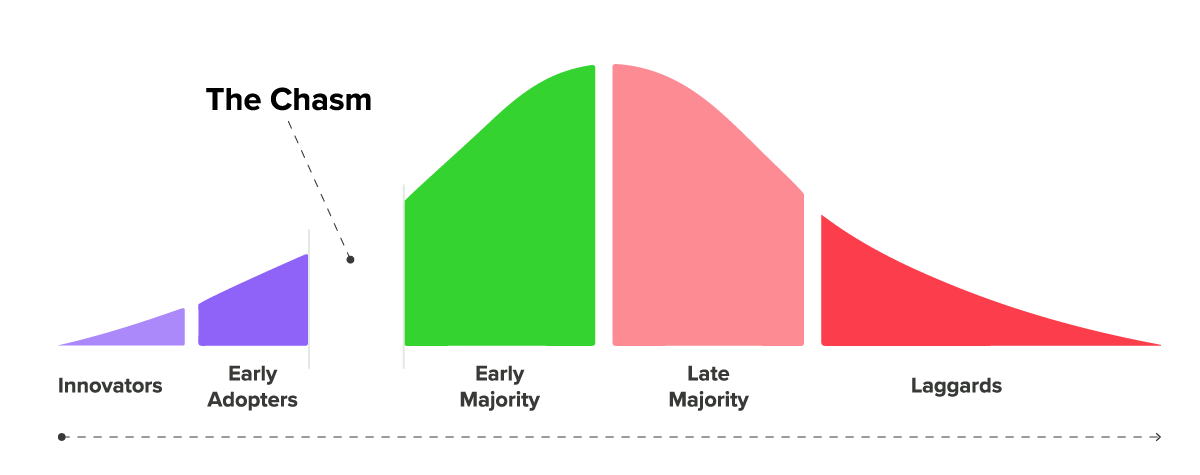
Image source: New Breed Revenue
The product adoption curve shows your product growth over time in a visual way. It reveals the number of people using the product at each stage of the adoption cycle against the percentage increase in total usage. You can track the adoption curve to understand how well your product fits the market and predict future growth.
The adoption curve is also known as the S-curve. It begins with a small number of users at the start, grows to a maximum as people rapidly adopt the product, and then declines as users gradually stop using the product.
The adoption curve helps you understand how new products or ideas gain traction and eventually reach a point of saturation. Let's discuss the user types you should pay attention to based on their place in the product adoption curve.
Innovators
Innovators are always looking for the newest and latest products. They want to be the first to experience the product. They are willing to take risks, even if it means paying a higher price, because they want to say they were the first to use the product.
Early adopters
Early adopters tend to be more risk-averse than innovators but still want to try out new products. They often try to find practical uses for new products and can be opinion leaders in their communities.
As an existing customer, an early adopter is essential for the success of a new product because their endorsement can help a product become mainstream and reach a wider audience.
Early majority
An early majority is a group of people only interested in products tested and validated by others. They base their purchasing decisions on the product's value and often wait for a price decrease before they buy. This group is crucial because it helps validate a product and make it more attractive to the late majority and laggards.
Late majority
The late majority is a very risk-averse group that is only willing to adopt new products once most of the population finds them valuable. Reaching the late majority stage on the product adoption curve usually means that the product has been completely validated on the market.
Laggards
Laggards tend to be more conservative and risk-averse than other groups in the product adoption cycle. They place a high value on safety and security and are often skeptical of new technology. As a result, they can be challenging to reach with new products.
Despite their resistance to change, laggards can be an important target market for new products and technologies. They may be more likely to adopt a new product or technology if it is recommended by a trusted source, such as a family member or friend or if it is necessary for their work or lifestyle.
Since we discussed the most important groups of users, let’s mention some key factors that impact their decision to adopt the product.
Five factors that influence user adoption

Image source: Pexels
Many factors can affect user adoption of a new technology or system. Some key factors include
- The ease of use and whether the product requires training
- The quality of the product and potential issues regarding usability, reliability, and performance
- The value of the product, including its price and cost-effectiveness
- The usefulness of the product in real-life situations
- Customer experience and satisfaction with the product, including customer service, technical support, warranties, and other features
Now, let’s discuss the most critical challenges that can decrease the product adoption rate.
Seven common barriers to product adoption
Product adoption is a complex process requiring users to undergo different stages before fully engaging with the product. Even if there are no universal rules for adopting any particular product, some common barriers might hinder your results. Let's give a short overview.
Lack of awareness
When starting a new product, getting the word out and building awareness among potential customers is essential. The best way to do this is through a comprehensive marketing campaign that includes advertising, social media, and other outreach efforts.
Building brand recognition can help more people learn about your product and consider adopting it.
Product complexity
Complexity can be a real problem for products. A product that is too difficult to use will drive people away. You can overcome this challenge by ensuring your instructions are straightforward.
By explaining the background and context of your product, you can help people comprehend it better and use it more effectively.
Multiple target audiences
Getting a new product off the ground can be challenging when it requires adoption by multiple groups of customers. You'll need to persuade each group of the product's usefulness to succeed.
It can be daunting, but if you can effectively communicate the product's benefits, you'll be well on your way to success.
High costs
A high price can prevent customers from adopting the product, while a low price can result in lost revenue.
Indirect costs, such as development, maintenance, or advertising, can significantly impact pricing. Therefore, it is essential to consider all aspects when setting the price for a new product.
Fear of failure
Some products are somewhat risky by their very nature. It is often the case with new products that are very innovative and cutting-edge. Customers may be hesitant to adopt them because they're unsure if the product will take off or provide support in the long run.
Fear of change
When trying new products, some people may be hesitant out of fear of change. They worry that their daily routines will be disrupted and their quality of life will suffer. By taking small steps and gradually adapting to new products, people can ease into the new way of doing things without sacrificing too much or entirely overhauling their routines.
Lack of trust
It's not uncommon for people to distrust new products, especially if they're unfamiliar with the company behind them. After all, it's easy to make false claims about a product's efficacy.
That's why it's essential to be clear and upfront about a product's background and results. Proper communication, testing, and documentation can help build trust and overcome initial skepticism.
Now you know what factors can slow the product adoption process, but how do you evaluate your results to ensure you’re on the right track? Start tracking product adoption metrics.
Ten most important product adoption metrics
Here are some metrics you can track to understand your product adoption better.
- Adoption Rate – measures how many people use a product or a specific feature.
- Conversion Rate – shows how many users perform a key action, i.e., sign up for your product. You can track conversion rates alongside daily active users to evaluate the effectiveness of your business strategy and marketing efforts.
- Time to Value – shows how long it takes people to adopt your product.
- Net Promoter Score (NPS) – shows how many existing customers would recommend your product.
- Usage Frequency – shows how often people use your product or a new feature.
- Activation Rate – measures how many of your consumers successfully activate, i.e., become long-term customers.
- Customer Lifetime Value – shows how much you can earn from an average customer over time.
- Churn Rate – shows the percentage of customers who leave your product. It helps you track your most valuable customer segments.
- Time Spent with Product – shows how much time people spend using your products.
- Retention Rate – lets you see how many customers stayed with your brand over time.
So now that you know what critical issues you might face and what metrics to track, let’s discuss how an optimized product adoption process should work.
Six steps of the product adoption process

Image source: Freepik
The product adoption process might differ depending on the industry. Here are the most common steps that drive product adoption.
- Credibility
During the first stage, potential customers learn of your product. You need to understand their needs and look for reasons that could persuade them to become regular users.
Brand recognition and credibility are essential at this point, as users will more likely try a product created by a company they already know and trust. The uniqueness and novelty of your product are also crucial.
2. Interest
When people are interested in your product, they will research to learn more about it. The more detailed and precise your product information is, the better. By providing accurate information, you can help people understand your product better and make a more informed decision about whether or not it fits their needs.
3. Evaluation
When customers consider whether or not to purchase your product, they evaluate it based on their specific needs. They will also compare your product to the competition.
At this point, providing a high-quality product at a reasonable price is essential. You also need to be aware of your product's strengths and weaknesses, capitalize on customers' positive feedback and persuade even more people to choose your product over others.
4. Trial
This step is crucial for software. The trial phase starts when potential customers want to test your solution and see whether it’s a good option for their needs. Free trials are a great way to show the features of your product.
Features aren’t everything, however. It’s also essential to provide an excellent user experience to motivate customers to sign up for paid plans.
5. Activation
Once a user knows your product and sees how it can benefit them, the next step is to activate it. It is usually done by signing up on the website or subscribing. Once customers complete this critical action, they are considered active users.
6. Adoption
Adoption is the final stage of introducing a new product or service when active users become regular users. It occurs when customers who have tried your product become convinced of its value and see it as a worthwhile investment.
For businesses, this is the ultimate goal. Getting customers to adopt your product or service is the key to long-term success.
Tracking customer experience is essential in each step of the process. Without the proper tools and metrics, you'll be left in the dark, making wrong decisions that can ultimately lead to the failure of your product.
To boost your product adoption, you should utilize user behavior tools that provide valuable insights into website or web app issues hindering your product growth. Let's discuss these tools in more detail.
What are user behavior tools?
User behavior tools help you understand how users engage with your product, let you monitor customer behavior, and enable you to improve product performance.
How user behavior tools help you improve product adoption
Designing products for your target audience becomes easier when you can identify user behavior patterns.
By monitoring usage data, you can clearly see which features are most popular and which issues you need to address with each new product iteration. This way, you can ensure that your products consistently meet your customers' needs.
We designed FullSession, our UX analytics tool, with these goals in mind. Let's make an overview of all features you can use to understand your users better and provide them with products aligned with their requirements.
How to speed up product adoption with FullSession
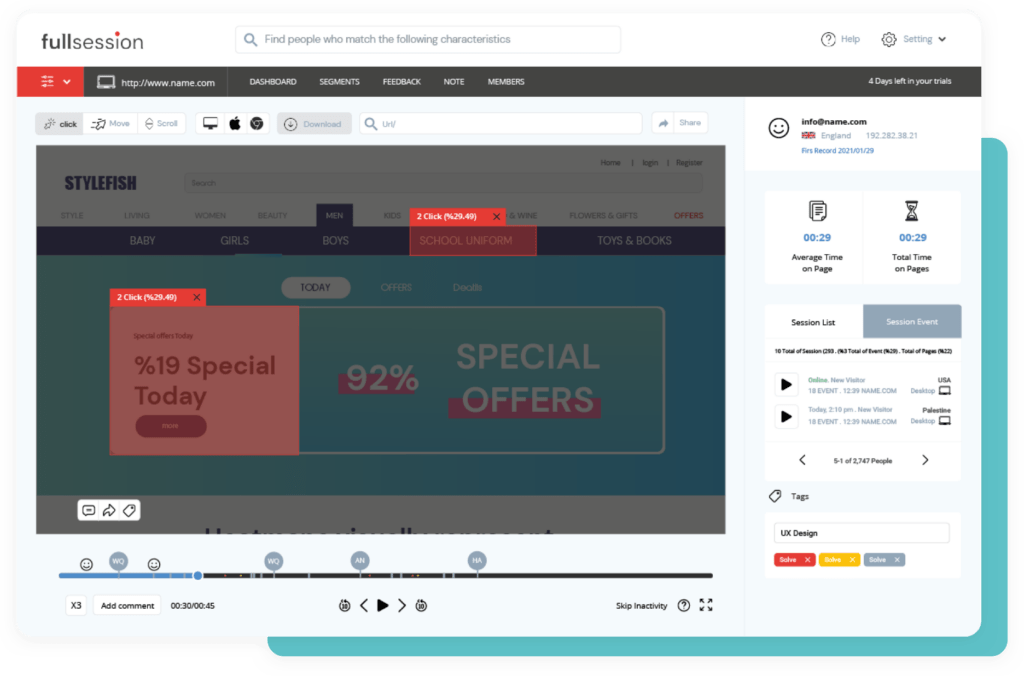
FullSession is a SaaS behavior analysis platform for customer journey tracking and conversion optimization.
It provides access to website visitor tracking tools, such as session recordings and replays, interactive heatmaps, and customer feedback tools.
With FullSession, you can conduct a customer experience analysis without affecting your website or web app performance, understand where to improve, and boost your product adoption.
Let’s discuss each of FullSession key features in more detail.
Session recordings help you track website visitors' actions
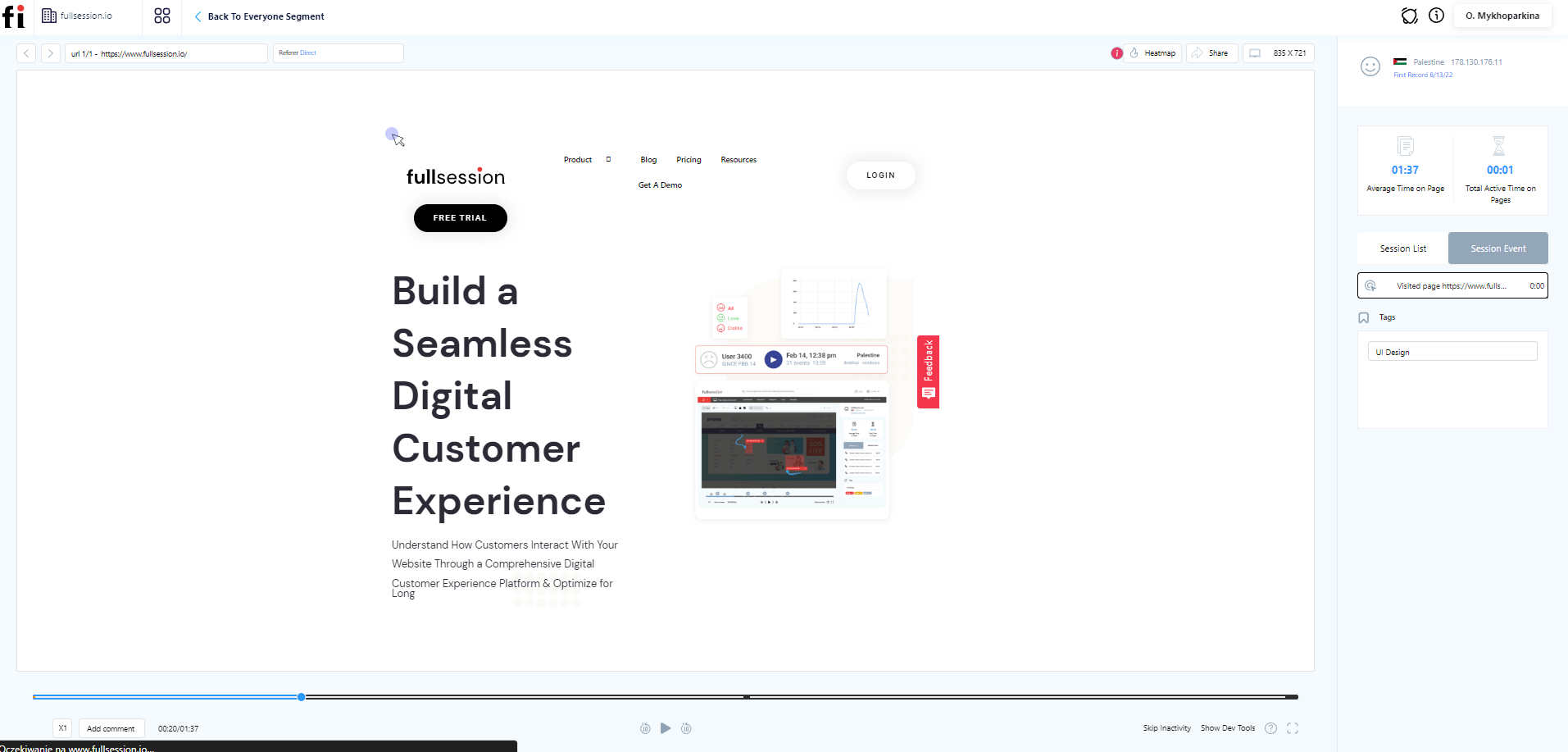
FullSession session recording and replay tools show how users navigate and interact with your website in real time. You can spot negative experiences affecting your product adoption rate.
Session replays help you spot significant issues during user sessions
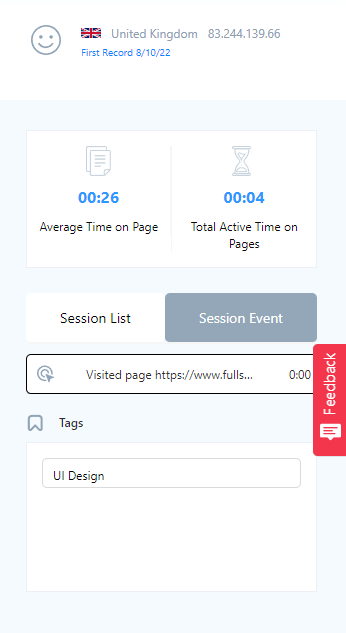
Aside from real-time monitoring, you can also look back and watch session replays. It’s an excellent way to notice worrying trends or problems that bother more than one user.
You can skip periods of inactivity, fast forward, rewind, and pause the recordings. You can spend as much time on the analysis as you want.
The session recording and replay provide the following data:
- Visited pages/URLs
- Visit source
- The country and IP address of the users
- Session list
- The session event data
- Screen resolutions
- Average time on page
- Total time spent on pages
Interactive heatmaps let you uncover UX and UI challenges
Website heatmap tools help you track user engagement with your website or web app. You can identify what page elements need a redesign, how to reposition critical sections of a page, or where you need to improve the content. FullSession offers three types of heat maps.
Click maps
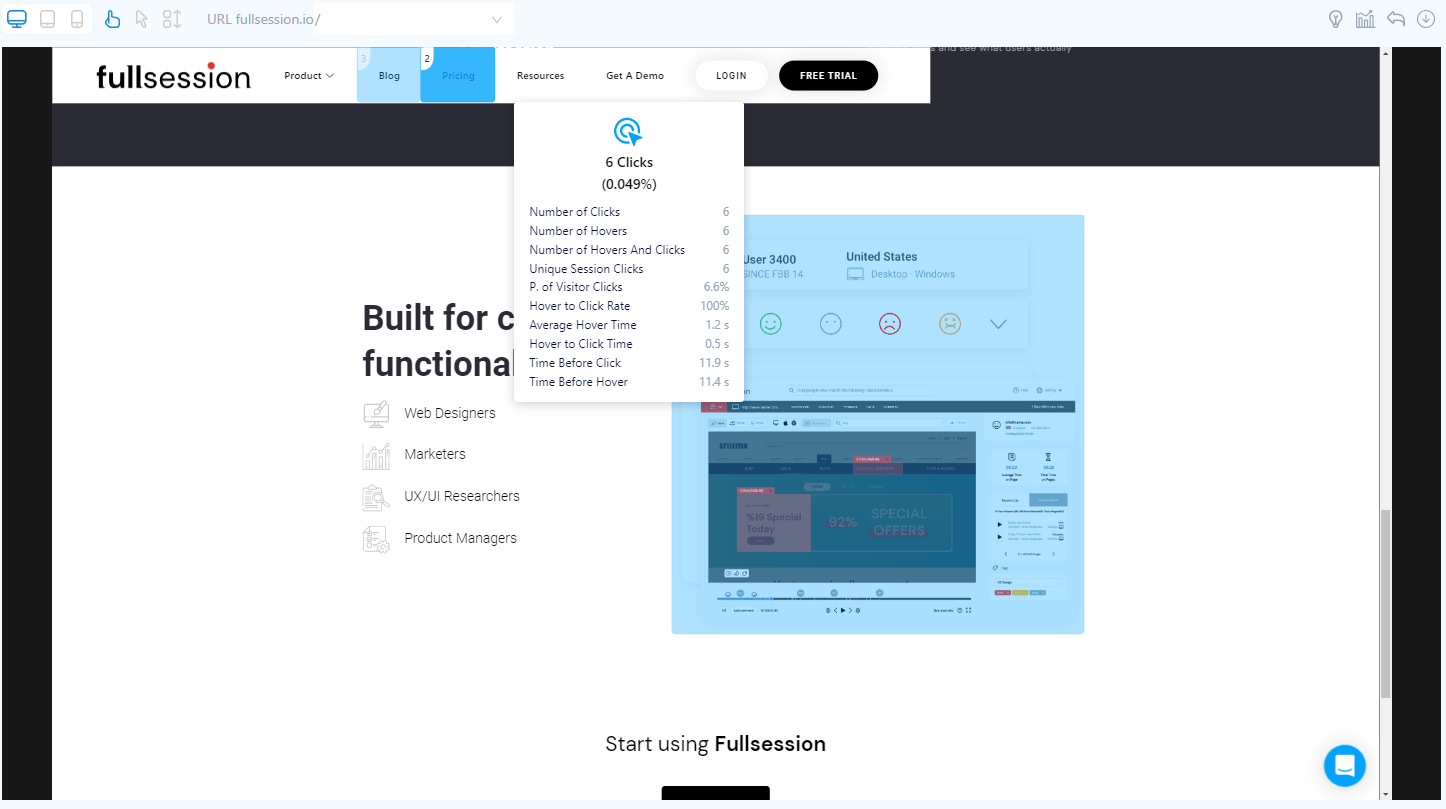
Click map is the first interactive heatmap that lets you see where people click on a page. Click tracking helps you understand which page elements or areas interest users the most.
Movement maps
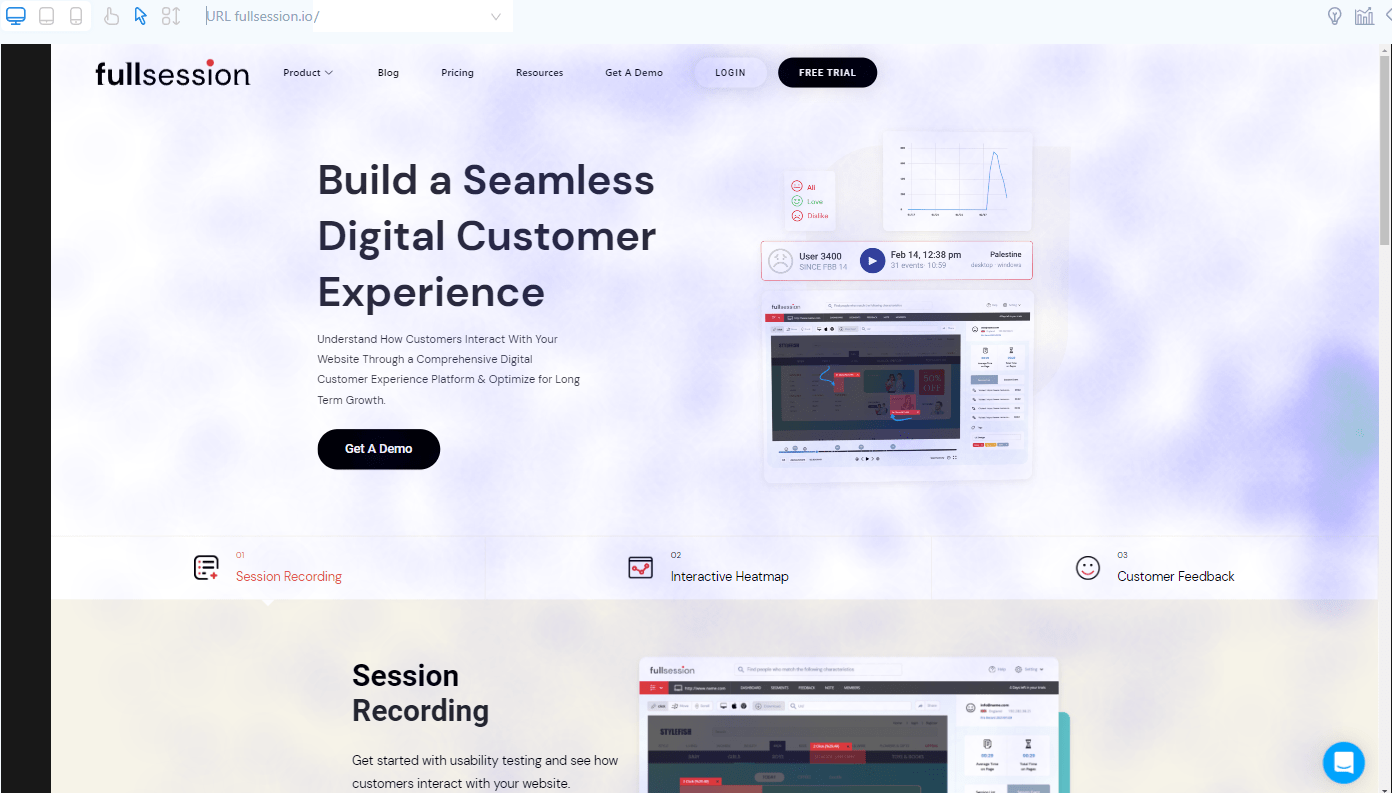
A mouse movement heat map is essential for tracking customer journeys on the website. You can identify what people avoid, where they encounter broken links that stop them from navigating your site, evaluate their ability to find what they need, and if they reach pages intended for conversion.
Scroll maps
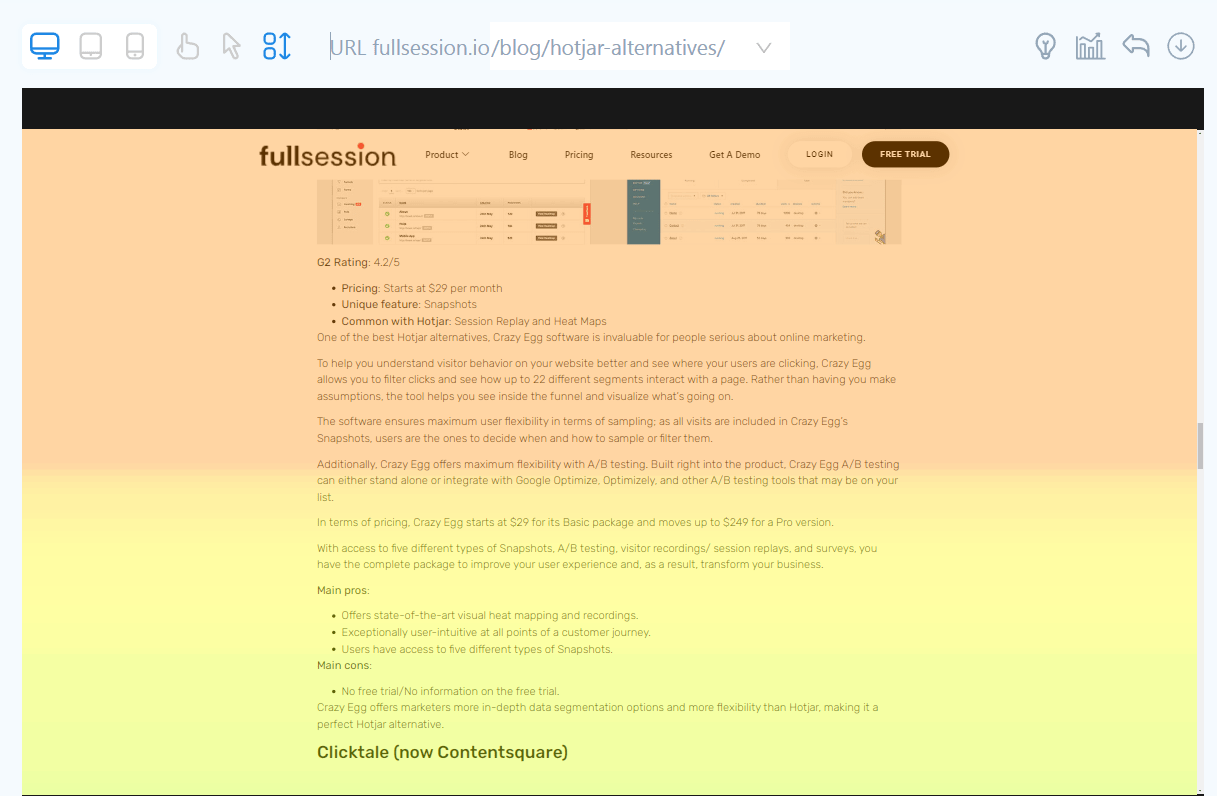
Scroll maps let you see how far users scroll down the page. This feature is essential to evaluate where to position crucial page elements such as CTAs, banners, links, or important messages.
Customer feedback forms let you track customer satisfaction levels

With FullSession, you can design customer feedback forms and align them with your branding. You can choose devices to collect the feedback, set up your questions, and decide if you want to receive answers via email. You don't have to invest in NPS software.
Customer feedback forms provide additional context for session recordings, as users can comment on issues they experience. You can watch what happened during a session replay. Users can also rate specific features and elements of your solution.
Customer feedback reports help you learn what to improve
With customer feedback reports, you can track customer feedback trends and monitor if their sentiment improves. Our dashboard provides access to all of your website feedback forms and their various details:
- Name of the form
- Creation date
- Author’s identity
- Activity status
- The number of responses
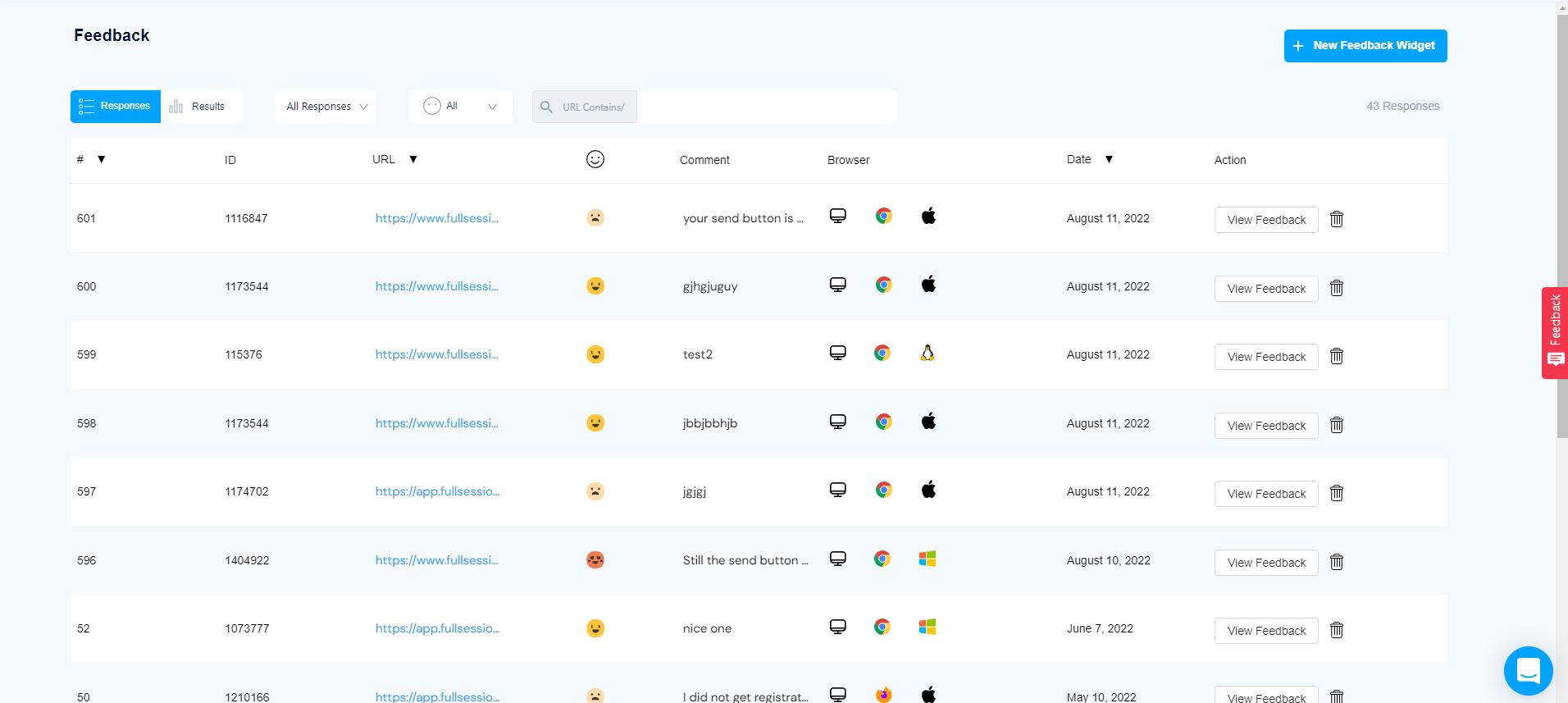
There’s also an Actions tab in the Feedback section of our Dashboard. You can see it on the rightmost side. It contains links to individual responses. You can click for more details:
- Form’s ID
- Date
- URL
- User sentiment (rating)
- User comments
- The browser used by the person
Advanced filtering options let you find issues faster
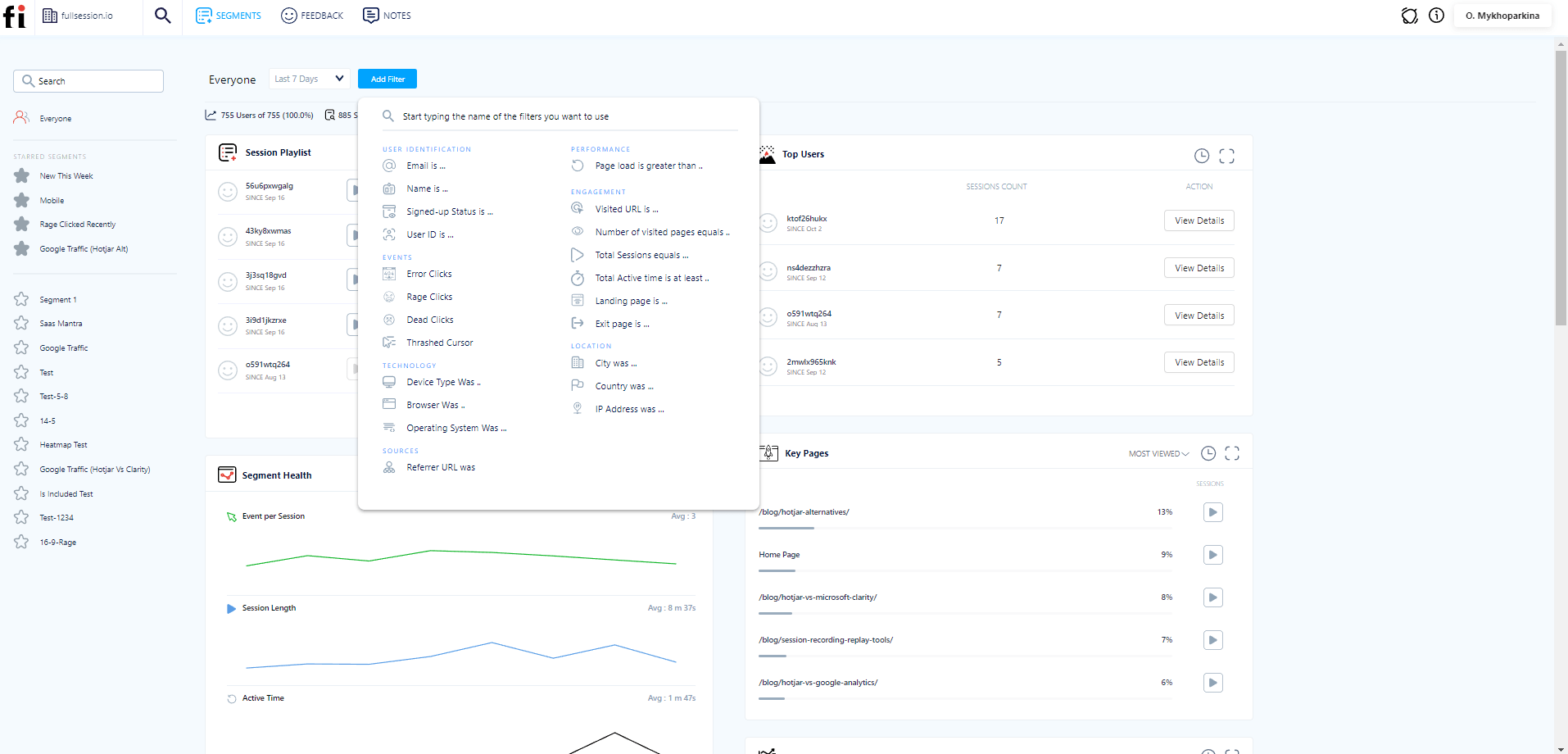
Our filtering options help you find whatever data you need with ease. You can identify specific events during sessions and focus on information that matters. Using the Notes feature, you can also share your findings with other team members.
Advanced analytics provides a wealth of user data
Finally, FullSession also has a metrics dashboard that gives access to details about your website and users. Here are some of the metrics you can analyze:
- Average page load speed
- % of sessions on mobile devices
- Median scroll depth
- Console errors
- The number of dead clicks and error clicks
- Trashed cursor
As you can see, with proper tools and advanced analytics, FullSession helps you build a seamless digital customer experience that will speed up your product adoption. Start your 14-day free trial to eliminate the guesswork and boost customer satisfaction.
If you’re interested in how FullSession compares to other user behavior tools, you will find the following section particularly useful.
Eight examples of user behavior tools
While developing FullSession, we researched other popular tools on the market.
Below you can find our articles on alternatives, competitors, and comparisons that will give you enough information to decide which product analytics tool gives you the most in-depth product metrics to boost your product adoption.
- Mixpanel alternatives
- FullStory competitors
- Lucky Orange alternatives
- Smartlook alternatives
- Contentsquare competitors
- Crazy Egg competitors
- Google Analytics vs Amplitude
- LogRocket competitors
- LogRocket vs FullStory
We covered FullSession in each to help you see how our web analytics platform compares to other solutions.
What to do next to boost your product adoption
Product adoption is essential for any business that wants to succeed. By understanding how customers think about your product, you can create a solution that meets their needs and expectations.
Additionally, making your product easy to use will help encourage customers to adopt it. Ultimately, by launching your product and helping it reach customers, you can ensure it is successful.
You can take advantage of user behavior analytics and user experience analysis to improve this process by gaining insights into how customers interact with your product and seeing what actions lead to higher levels of adoption.
A platform like FullSession lets you observe how people use your website via session recordings and replays. You can also use interactive heatmaps to gain additional insights about the user journey and get feedback directly from users via customer feedback forms. FullSession also makes data easy to find thanks to powerful segmentation and filtering features.
Schedule a demo or start a 14-day free trial to see our platform in action.
FAQs about product adoption
Here are answers to some common product adoption questions.
What is product adoption in SaaS?
Product adoption is the process by which a new product or service – such as SaaS – is adopted by its target user. The key to successful product adoption is making the technology easy to understand and use by the target users while providing high value for an affordable price.
How do you measure product adoption?
You can use various tools to monitor product adoption metrics. For example, you can look at signups, monthly active users (MAU), website traffic, and more.
How do you promote product adoption?
There is no one-size-fits-all strategy for promoting product adoption. It depends on the types of challenges your product faces. Some companies focus on educating users about the benefits of their solutions, while others concentrate on incentivizing users to use their products by offering rewards, discounts, and similar.
How can you improve adoption in customer success?
Customer success teams can significantly improve adoption rates by providing thorough and complete training, working closely with IT teams, and providing ongoing support and guidance. By focusing on these three areas, customer success managers can increase the likelihood that their customers will become successful adopters of their products and services.